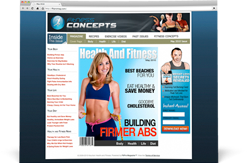When you’re in the personal training business, you really have to sell yourself. The competition is fierce and it’s a fact that many people choose a trainer randomly. Maybe you’re the number one spot on Google, or it could be that they saw your sign in a tanning salon. Regardless of WHERE they saw you, the point is that you were visible. I firmly believe that you shouldn’t limit yourself to just one means of advertising; have many different balls in the air at any given time. Though there are a million different ways to get your name out there, here are my top 6 tips to selling personal training.
1. Use the referral system – When you sign up clients, require that they provide at least 5 referrals on your personal data sheet when they’re doing their paperwork. You can even take this a step further by offering an incentive to anybody that actually brings you another client. Offer a free training session and praise them generously in front of your other clients when they bring a guest.

2. Network with other businesses – Local tanning salons, hair salons, sporting goods stores, nail salons, daycares, clothing shops, nutrition shops and chiropractors are all great places to target when selling personal training because that’s where your clients frequent. Offer a few free sessions to the employees in exchange for letting you hang your fliers or leave your business cards. Many places will let you leave your cards for free, but if you offer a free session to the employees, you may just turn them into paying clients, too.
3. Build a killer website – We live in a world where people choose everything from their restaurants to their doctors on their mobile devices. If you don’t have a web presence, you’re missing out on a huge percentage of clients. Be sure to do some keyword research and optimize your content with those keywords so that you rank as high as possible. Use plenty of client testimonials, strong headlines and engaging content that really showcases what makes you the best. This is no time to be humble. Put yourself out there and sell yourself!
4. Offer Smaller, Specific Classes – Advertise classes of short duration such as a “2 weeks to flatter abs” class, a “21 day fat burning” class, or something else that’s popular in your area. Really put your best foot forward during these sessions by being friendly, passionate and enthusiastic. Show an interest in the personal success of each client and be available for questions before and after class. Don’t be afraid to promote yourself a bit; after all, selling personal training sessions is your marketing goal here. (more…)
Learning to love sales can be tough when your background is personal training, but if you’re looking to grow your business with new clients then you need to become an expert closer. Marketing will only take you so far, you’ve also got to be able to convert your prospects into paying clients if you’re looking to make the big bucks- and you can only do that by selling.
Selling personal training has gotten a lot easier over the years due to the fact that more and more people have taken a bigger interest in their own health and fitness. Because health and fitness are becoming more “front and center” in people’s lives, closing even the toughest customers is now a breeze compared to years ago when everyone was under the impression that you had to be rich or famous to hire a personal trainer.

Now that our society is a lot more aware of the harmful effects of obesity, more people are looking at getting fit as a way to curb medical costs- and they’re right to do so. Eating right and getting enough exercise can help anyone in almost any situation avoid costly doctors visits and not to mention help them feel a lot better, so it’s no big secret that most doctors will prescribe a patient a healthier diet and more exercise if they aren’t getting enough.
So what does all this mean for you and your personal training business? It means everything! Personal training, group or boot camp or one-on-one, is on the up and up meaning that more people are seeking a personal trainer to work with. They’re already easier to sell than ever before so all you need are these quick selling tips to get you on the right track with your prospects.
Trial Offer
One of the best ways to gain a prospect’s trust is to offer them something of value for free or cheap. A week free at your facility will help them get used to your personality and your style of training, which will help you when you’re ready to sit down and sell to them. They’ll already be familiar with what you have to offer so your consultation will be more focused on them and what they want to accomplish.
That’s much easier than sitting down with a prospect that you barely even know, who doesn’t even know you at all, and trying to sell them a year’s worth of personal training for whatever price. The key is to get them to know you, like you, and trust you before you even end up selling to them because it makes the process that much easier for you and for them.
So if you’re not offering some free or cheap (a week free or two weeks at $45 or whatever feels right to you) trial at your fitness center then start doing so and promote it online, offline- pretty much everywhere you can to get people interested in joining. Your prospects will be much more likely to buy if they can take your training for a “test drive”.
Ask Questions, Then Listen
The secret to closing is basically this: ask questions, then listen- hard. Even the world’s best salespeople know how important it is to let the prospect do the talking. It’s where all the magic happens, it’s where you can pinpoint the exact reason they came to workout with you in the first place and that’s your golden ticket.
Asking important, qualifying questions like, “When is the last time you felt good about the way your look and feel?” or “Tell me about the last time you felt good about your fitness” will help you figure out just what it is that’s holding them back from (more…)
Most personal trainers starting out don’t have a lot of resources to market their business with and that can cause a huge problem down the road. When you’re looking to grow your business and get new clients- marketing is your best friend, and without it you’re missing out on a lot of potential business.
Marketing a personal training business with a limited budget means getting creative and trading your “time for dollars” so that you can eventually end up trading your “dollars for time”. One goal you should try to accomplish with your gym or boot camp early on is to be able to afford to pay someone to do the day-to-day work for you, if you don’t already have a staff on hand so you
But don’t think that you have to go out and hire a giant marketing firm because when it comes to fitness marketing, there are tons of ways to get the word out without having to spend tens of thousands of dollars for a marketing plan from these big wigs. You really can do this on your own- and when you’re a business owner, a lot of the time you’re a marker first, and a business owner second.
You should really try to make marketing a part of your daily operations because you’ll only benefit that much more from it. So with that being said, here are the best low-budget marketing strategies that you should start implementing today:
Speak Up
Building authority is important when you’re a business owner. You want people to know you, like you, and trust you and building authority will help make that process easier.
Speak at local health and fitness events and if there aren’t any in your area, then look a couple of towns over or maybe think about hosting your own seminar on health, fitness, and nutrition and invite other health professionals in your area to speak as well.
Write for local newspapers too. Get in touch with the top newspapers and their editors around town and ask how you can contribute. Same with radio, if you know anyone in radio- ask how you can offer fitness tips and other health related content for a morning show or what have you.
Don’t forget to start blogging. Blogging about health and fitness will easily build up your authority, especially over social media. Starting a blog and updating it consistently with useful content will help you gain attention from those in your area, and that will make them more likely to seek you out when they’re ready to get into shape.
If you’re not confident in your speaking or writing skills, then brush up on it and start practicing. As a fitness business owner- you should aim to be the “go-to” expert in your area because it will help you pull in those customers who have probably tried everything in the past and couldn’t get results.
Get Seen
In addition to contributing to newspapers and starting your blog, you should also start posting Youtube videos of yourself demonstrating different exercises and workouts or sharing a favorite healthy recipe of yours. Those who know you will more than likely share your videos, especially if they’re any good.
What makes a good video? Anything that is helpful, valuable, and compelling to your clients and prospects. This is where “knowing your niche” really comes into play. What does your ideal client do for a living? What keeps them awake at night? How old are they? What gender are they? All of these questions will help you to create amazing videos tailored specifically for your target audience. (more…)
Starting a business is never an easy thing, no matter what kind of business it is. But when you’re a one-on-one personal trainer running around town to meet your clients or work in a big box gym with barely any benefits then you know how exhausting that can be. It’s hard to sustain that lifestyle so that’s why a lot of personal trainers decide to take the plunge into starting a fitness business of their own.
So how do you go about starting one? Here, we lay out the steps you need to take to successfully set up your business so that you can start profiting ASAP.
Decide Your Demographics
The first step in starting your personal training business off on the right foot is to decide who your ideal client will be. This is probably the most important step as it will help you determine what kind of fitness studio you’re trying to create.
Are you looking to run a boot camp? Who would benefit most from that style of training? Are you more of a one-on-one trainer? What kind of client would benefit most from one-on-one? Could they afford it?
Not only will knowing your demographic/target market help you narrow down on what type of fitness business you want to run, it will help you to create an effective marketing message. And having an effective marketing message will help you get clients because they’ll feel like you’re speaking directly to them. Choose who you are going to serve and learn their language so you can demonstrate the value and benefits that your services will bring them.
Marketing is Vital
You can’t just build a fitness studio and expect people to just flock to it. You’ve got to market, market, and market some more- that’s why it’s so important to know WHO you are marketing to.
Now if you don’t have much of a marketing background or budget, don’t get discouraged. There are tons of ways you can get the word out about your brand new gym without having to know or spend a whole lot. You just have to keep in mind that the #1 thing you need for effective marketing is a demographic or a niche. That alone will help focus in on your marketing campaigns.
Here are some low and no cost marketing strategies to get you on your feet: free Saturday boot camps (works best if you’re a group personal trainer), email marketing, social media marketing, contests and fitness challenges (must give away awesome prizes), Human Billboard method (train 20 people at a discount in exchange for referrals), giving out “bring a friend” certificate when someone joins your gym or signs on as a member, starting a referral rewards program for clients who bring in their friends and family, teaming up with local businesses to create a strategic partnership, become the “go-to” fitness expert in your area… just to name a few. (more…)
For today’s personal trainers and boot camp owners the Internet is king. It’s the thing that’s going to get you a constant surge of new clients whenever you need them and will give your business a platform to reach a bigger audience. Now, that’s not to knock offline personal trainer marketing methods because, in all honesty- you should be doing both, but if your business lacks a web presence then there is no way you can grow and take it to the next level.
Listen, most of your customers (if not ALL of them) are online just waiting for you to find them and inspire them to want to get healthy and fit. So do them, and yourself, a favor by making your business known online and in the community you live in.
A lot of these tools and tactics that we’re going to lay out for you, you may already have in place- which is awesome. But if you’re missing one or more of these tools in your business’ tool belt, then you might be missing out big time.
Here’s what you need for a powerful web presence:
Facebook
We’re starting with Facebook first because it is, without a doubt, the most powerful and most important social media site that your business needs to be set up for. Period.
Did you know that over 15 million businesses use Facebook for their marketing campaigns?
That just shows you how crucial it is to have one for your business. But you can’t just set one up and forget about it, you actually have to be using it to engage your potential and current clients.
Not only can you reach more people through Facebook, you can reach your target audience and the specific people who are most likely to become your clients. And that’s what makes the biggest difference. You can actually build an audience for your business, an audience that’s excited to hear what you have going on.
So, how do you do that? By posting content that your potential clients will find useful, helpful, or inspirational. Start by introducing yourself and your business. What are you all about? Write that in your “About Me” section. Then get to posting.
Share things on your Facebook like healthy recipes, tips for a good workout, and, of course, testimonials and case studies. Post pictures of clients working out and having a great time with it. Those who are interested in joining will get to see what it’s like working out at your boot camp or personal training studio.
You also don’t want to spam your audience with promotion after promotion after promotion. Pick and choose carefully when you’re going to launch a promotion and then go all out. Don’t run multiple promotions and sales at the same time either, it makes it harder to track what works and what isn’t.
Yelp
Yelp is becoming more and more important for small businesses because it’s the #1 business review site.
Yelp is necessary for two main reasons: reviews and local SEO. If you have an awesome personal training business that your clients rave about, have them rave about it online on your Yelp. It helps not only with your reputation as a business, it helps with “word-of-mouth” referrals and convincing those who are looking to join your gym
SEO stands for search engine optimization and it’s what makes your business searchable when someone is looking for personal training in your area. So if someone types in “personal training in Los Angeles” (or whatever city you live in) your goal is to have your businesses website or Yelp show up on the first page of Google, Yahoo!, and Bing.
Yelp is owned by Yahoo so it’s having an account not only helps with your Google searches, it helps with your Yahoo! and Bing searches as well.
Google Places
Similar to Yelp, Google Places is a big deal and definitely something that you need to set up for your business ASAP if you haven’t already.
Having your business listed on Google place not only helps people find your business online, it helps them to see your hours of business and gives directions to your facility. People can also leave reviews here and you’re able to connect with your clients like you would on any other social media site.
It also helps with SEO and since Google Places is owned by- you guessed- Google, you’ll have a much better chance at your business showing up when someone searches for it, especially on Google because it’s the #1 search engine used. (more…)
Guest Post by Copy Sipe, PhD
While at the 2014 Fitness Business Summit, I gave a presentation on “The Perfect Storm: How to train the largest and wealthiest untapped market in fitness history!” to over 500 fitness professionals. After my presentation we were just slammed with trainers interested in the Functional Aging Specialist certification because they realized how huge the potential is for training mature clients.
Later that night, at the VIP dinner, a young female trainer stopped me to tell me a little about her facility and get some advice on how to reach more mature clients. During that conversation she asked me “This question might sound stupid but am I too young to train older adults?” This isn’t the first time I have been asked this question and it is definitely not a stupid question.

I assured her that her age was really not that big of a deal (the trainer looked like she was in her early 20’s although I didn’t ask). What really mattered were things like her level of maturity and professionalism; having good communication skills; understanding that mature adults have different values, needs and desires than her younger clients; knowing how to train them appropriately, safely and effectively; and creating an environment that they feel comfortable in.
Most mature clients (ages 50-70+) don’t really care about the age of the trainer IF they feel confident that the trainer knows what they are doing, how to meet their individual needs, has an appropriate amount of training (degrees, personal trainer certifications) and experience and conduct themselves appropriately. A HUGE turnoff to this population is trainers acting immaturely. Things like talking about their weekend exploits, talking negatively about other trainers (or the owners or other clients), showing up late to appointments, constantly texting or checking their phones, and so on.
The advantage that age has for trainers in their 30’s and up is credibility and authority. It is much more difficult to establish yourself as an authority if you are really young and don’t have much experience. Mature clients value experience and respond well to authority. So if you are a veteran trainer then you can use this to your advantage. Highlight the amount and types of experience that you have including certifications, degrees, presentations you’ve given, articles you’ve authored and notable individuals you have worked with.
Both younger and more seasoned trainers can use the authority and credibility of the Functional Aging Specialist certification to promote themselves to mature clients. The FAS is a cutting-edge program that is based on the most current research and developed by two award-winning, experienced, PhD trained professionals. By aligning yourself with our credentials and those of FAI you associate yourself with credibility, experience and authority. Since FAS is pretty new you could very well be the first and/or only trainer in your city or even state to have this credential. You should use this to your advantage by letting everyone know that you are unique… press releases, email blasts, website announcements, byline, front window decal.
You can do that locally as well. Write and present with other local authorities like physicians, chiropractors, therapists, nutritionists and even other trainers. Demonstrate publicly that you have the skills, knowledge and credentials so that you can become that local “go to” expert for training mature clients. (more…)
Guest Post by Cody Sipe, PhD
Training mature adults effectively is about more than just meeting their physical needs. If you want to grow your business with this gigantic market then it is critical that you understand who they are. What makes them tick. What appeals to them. What repels them. What they respond to. What characteristics they look for in a facility or in a trainer.
Getting them to train with you involves more than just having a personal training certification, creating a slick flyer, having a great name or tagline, or giving a big discount. Like with any other target market you’ve got to be inside their heads. Most importantly it is vital that you understand, appreciate and then appeal to their core values. If you want their business you need to earn their business.
Here are some key values that you can use to appeal to potential mature clients:
Family

Mature adults love their family. They want to be able to spend lots of quality time with them. They worship together, eat together and play together. The Boomers are often called the “sandwich generation” because they end up caring for their aging parents and supporting their adult kids and/or grandkids at the same time.
In fact, a large percentage of them financially support their adult children. Those that are grandparents are especially fond of their grandchildren. Grandkids are the apple of their eye. They would do almost anything for them. And they would do almost anything to be able to spend time with them.
You want to appeal to mature adults then appeal to their sense of family. Tell them how your program will help them to play with their grandchildren, explore Disneyworld with them and climb the bleachers at their sports competitions. Show images of families and grandchildren spending time together. Talk to your current clients about their families and grandchildren. Give them an opportunity to brag a little. Have times or events where they can bring their families to the facility so they can see where “grandma” and “grandpa” work out.
Socialization
This might seem obvious but it is important to both recognize and utilize this fact. We use small group personal training because it provides a great avenue for socialization. Clients that exercise together in groups of 4-6 develop great relationships. The group provides great support to one another and helps them to stay accountable for exercise. It can be challenging, at times, to corral the conversation and keep everyone exercising but they have a great time and the session flies by quickly.
Highlight the relationships that exist between members in your facility. When they come to check out your facility introduce them to some of the other clients. Highlight your clients in your blog emphasizing your relationship with them. Communicate how your program can help them stay socially connected.
Spirituality and Faith
As people get older and travel through mid-life their spiritual and religious beliefs typically deepen and become more meaningful. Faith becomes even more important than in their younger years. Whether or not you have a deep faith or not doesn’t matter. A large majority of mature adults do. Sometimes what you don’t do is just as important as what you do. (more…)
Guest Post by Cody Sipe, PhD
If you are going to grow your business and learn how to be a personal trainer with the exploding population of older adults then you need to quickly learn how to deal with osteoarthritis. It is the most prevalent chronic condition among older adults and by far the most common complaint that we get from clients. Arthritis has a major impact on functional abilities and is one of the primary causes of disability.
It is also a painful condition that takes a mental and emotional toll on those suffering from it. Just think about constantly having to take NSAIDs (non-steroidal anti-inflammatory drugs) or other pain killers because your joints hurt all the time. Pain is a downer that can suck the joy out of the things we love to do. Traveling. Playing with grandchildren. Taking a walk with a spouse or friend. Hiking. Almost anything.

Frankly, I think it is a major pain in the butt (or the knees to be exact). And I know because I already have arthritis in my knees even though I am only in my early 40’s. If I play a game of pickup basketball…watch out. I know that I probably won’t be able to get off the toilet the next day because my knees hurt so badly. For our clients just daily activities can cause major arthritic pain. The joints that are most commonly affected include the knees, hips and spine.
It is also one of the major reasons older adults are fearful of exercise. They think that since daily activities bother their affected joints then exercise will make it worse. In their minds this is confirmed when they go out and do something active and they have to “pay for it” with pain and inflammation the next day or two. In actuality regular exercise eases joint pain and increases function. But most older adults don’t understand that so they tend to avoid exercise altogether.
If you’re getting ready to take your personal trainer certificate and don’t know how to train mature clients with arthritis effectively then you won’t keep them. They will leave and your business will suffer!
Recognized recommendations for arthritis include:
· Using low or no-impact cardiovascular exercise modalities such as swimming, biking or walking
· Avoiding high-impact activities such as skiing and running
· Performing resistance exercise using higher reps and lower weight for the musculature surrounding the affected joints
· Extended warm-up to make sure joints are well-lubricated before exercise (which may include a hot shower beforehand)
· Weight loss if the individual is overweight or obese
· Use of NSAID’s to manage pain and swelling
· Avoiding exercise if joint during periods of active inflammation (joint is red, hot and swollen)
Tips for the Trainer
Appease their Fears and Concerns: The fear of pain and injury is often still present even for the ones who decide to hire a personal trainer. They may doubt their own abilities or may have had negative experiences with exercise previously. If they are scared then they are not going to give you a good effort and thus they are not going to get the results they are after. Let them know what to expect with an exercise; how it might affect their arthritic joints; and how you will modify the exercise if it bothers them too much.
For new exercisers it can be very helpful to let them know how to warm-up properly and what to do post-exercise to minimize pain and discomfort. Communicating effectively will build their trust and confidence in you as a trainer and increase your credibility as an authority while reducing their stress about the potential dangers of exercising.
Decrease Depth: I find that decreasing range of motion of exercise movements can really help clients perform them successfully while minimizing discomfort. On movements such as squats and lunges this means decreasing the depth at which they work or decreasing the height of their step. For some there is a critical range of motion beyond which their pain or discomfort increases significantly. This is true for me. I have learned that performing leg movements to about 75 degrees of knee flexion is about all I can tolerate and still work at heavier loads.
Once I go beyond that range it becomes very uncomfortable for the day or two after the exercise session. Determining an appropriate range of motion for your client is often a process of trial and error which includes diligence on the trainer’s part to ask the right questions regarding post-exercise discomfort and discernment to know when an exercise needs to be modified or removed.
Be Methodical: Therefore, do not implement multiple changes simultaneously because you will not know which change was problematic for the client or it was the sum of all changes that caused them discomfort. For example, you increase the load on a lunge (by having them hold dumbbells) and increase the depth of their lunge and have them step onto a balance pad all in one session. The client comes back saying that their knees really killed them the next day.
Since you made three changes in one session you really don’t know if the issue was increased loading, increased range of motion, decreased stability or a combination of 2 or more of these that caused them so much discomfort. Manipulate the most important variable first and once that has shown to be tolerable then manipulate the second variable and so forth. (more…)
Ahh… marketing. Often called the “lifeblood” of any business- and it’s completely and totally true. Without marketing, clients don’t know you exist and how can you grow your personal training business if your potential clients don’t even know you’re out there?
But for a lot of us, the marketing gene just doesn’t come naturally. We’ve spent most of our time on learning the best techniques to help our clients lose weight and look great, which is exactly what we should be doing, but owning and operating your own business means that there are other skills you need to learn and master. Marketing is definitely one of them.
Marketing a fitness business doesn’t have to be complex or that expensive (there are tons of free and low cost marketing strategies for you to roll out here on this site). It does, however, have to work in order for you to see a return on your investment so learning the ins and outs- the do’s and don'ts of marketing is incredibly important for growing your business.
Taking the time to learn more about marketing is what will help you grow your fitness business into the six or seven figure business that it was meant to be. The business that you, as a hard working fitness entrepreneur, deserve.
So, if you’re in need of a little fitness marketing boost to get more clients in the door then listen up! These five tips will have your business booming in no time.

Specialize, Specialize, Specialize
Okay, so if I could only give you one single piece of advice for marketing it would be this: pick a target market and stick to it. That’s it. This one little thing will help you harness more earning power because you’re not generalizing- you’re specializing and those who specialize in a specific market are able to charge more without having their clients bat an eyelash.
Another reason why you’d want to specialize and pick a target market is because your marketing message will come across a whole lot clearer, allowing you to speak directly to those you are trying to serve. And that is what will get you more clients. Clients who are excited to give your boot camp or personal training a try because you were able to speak their language.
Sometimes deciding what niche to serve is tough because, as a personal trainer, you know you can help just about anybody lose weight, tone muscle, and improve their overall strength. So picking just one group to market to seems like you’re shutting everyone else out, but in order to earn the big bucks- you got to find the one market that you can help the most.
One way to figure out what market you might serve best is to take the time to really think about your style of training. What interests you the most when it comes to training people? Who would be your ideal client? When you’re able to narrow it down, think about the problems that your program would solve for this market and make that your message.
For instance, busy moms have a tough time getting their workout in so if you have a program that whips them into shape without making them spend hours upon hours working out then that’s your market and your message.
Get Online
Get your business online and do it now if you haven’t already done so. Having a web presence is so important for growing your business nowadays that if you’re not online and using all of the social media sites that are available to you, then you’re probably leaving thousands upon thousands of dollars on the table and who knows how many clients out in the cold.
If you don’t have a website yet, then that’s okay. You can still utilize Facebook, Twitter, Yelp, Google+, and any other social site you can think of as a placeholder until your site it set. (more…)










